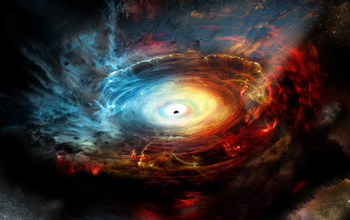Multimedia Gallery
Black hole hidden within own exhaust
An artist's impression of the heart of galaxy NGC 1068, which harbors an actively feeding, supermassive black hole. Arising from the black hole's outer accretion disk, the Atacama Large Millimeter/submillimeter Array (ALMA) discovered clouds of cold molecular gas and dust. This material is being accelerated by magnetic fields in the disk, reaching speeds of about 400 to 800 kilometers per second. This material gets expelled from the disk and goes on to hide the region around the black hole from optical telescopes on Earth. Essentially, the black hole is cloaking itself behind a veil of its own exhaust.
More about this image
Supermassive black holes, millions to billions of times the mass of our sun, are found at the centers of galaxies. Many of these galactic behemoths are hidden within a thick doughnut-shape ring of dust and gas known as a torus. Previous observations suggest these cloaking, tire-like structures are formed from the native material found near the center of a galaxy.
Now, new data from the Atacama Large Millimeter/submillimeter Array (ALMA), however, reveal that the black hole at the center of a galaxy named NGC 1068 is actually the source of its own dusty torus of dust and gas, forged from material flung out of the black hole’s accretion disk.
This newly discovered cosmic fountain of cold gas and dust could reshape the understanding of how black holes impact their host galaxy and potentially the intergalactic medium.
To learn more, see the NSF News From the Field story Black hole hidden within its own exhaust. (Date image taken: unknown; date originally posted to NSF Multimedia Gallery: Dec. 16, 2016)
Credit: NRAO/AUI/NSF; D. Berry/Skyworks
Special Restrictions: NRAO Image Use Policy NRAO images and videos may, on a non-exclusive basis, be reproduced without fee on the conditions outlined in the NRAO Image Use Policy. This image is copyright protected on behalf of NRAO, Associated Universities Inc. (AUI) and NSF, and is licensed for use under the Creative Commons Attribution 3.0 Unported license (see http://creativecommons.org/licenses/by/3.0/). Please read both of these documents before using this image.
Images and other media in the National Science Foundation Multimedia Gallery are available for use in print and electronic material by NSF employees, members of the media, university staff, teachers and the general public. All media in the gallery are intended for personal, educational and nonprofit/non-commercial use only.
Images credited to the National Science Foundation, a federal agency, are in the public domain. The images were created by employees of the United States Government as part of their official duties or prepared by contractors as "works for hire" for NSF. You may freely use NSF-credited images and, at your discretion, credit NSF with a "Courtesy: National Science Foundation" notation.
Additional information about general usage can be found in Conditions.
Also Available:
Download the high-resolution JPG version of the image. (425.2 KB)
Use your mouse to right-click (Mac users may need to Ctrl-click) the link above and choose the option that will save the file or target to your computer.



